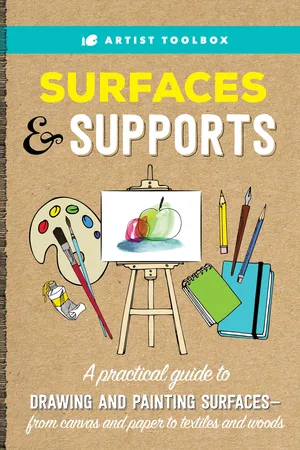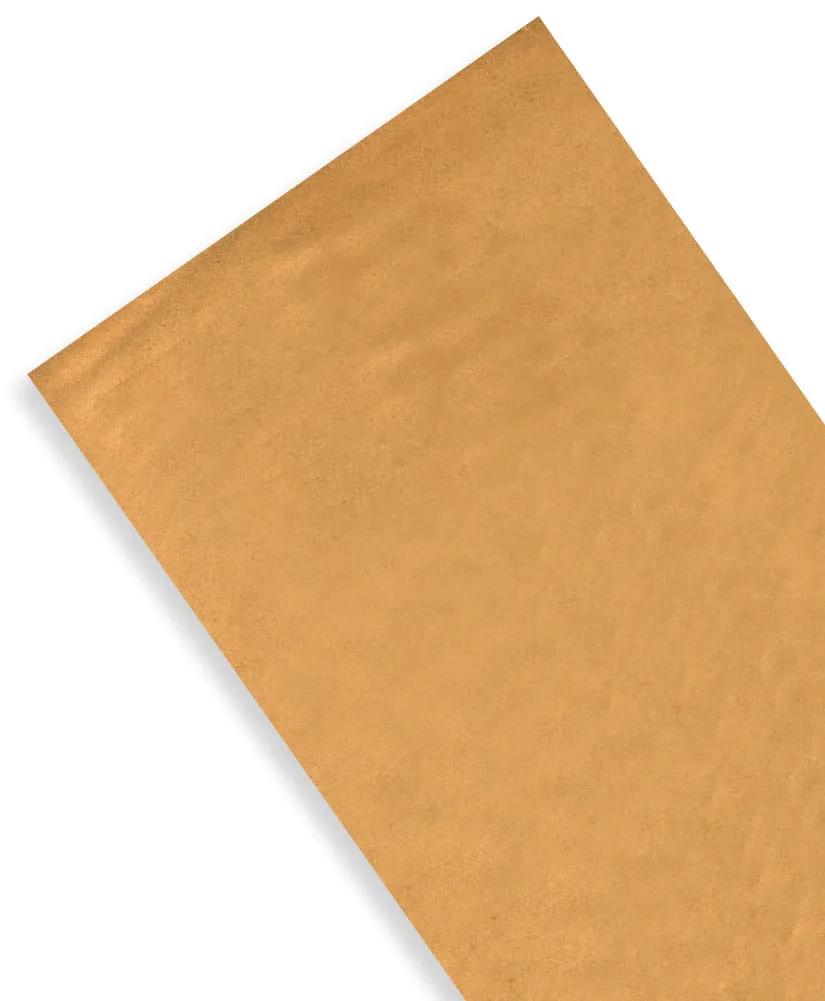
eBook - ePub
Artist Toolbox: Surfaces & Supports
A practical guide to drawing and painting surfaces -- from canvas and paper to textiles and woods
- 112 pages
- English
- ePUB (mobile friendly)
- Available on iOS & Android
eBook - ePub
Artist Toolbox: Surfaces & Supports
A practical guide to drawing and painting surfaces -- from canvas and paper to textiles and woods
About this book
Artist Toolbox: Surfaces & Supports explores a wide range of drawing and painting surfaces and the unique effects they have on a variety of media.
The surface you draw or paint on impacts everything in your artwork, from its texture and brightness to color and durability. Artist Toolbox: Surfaces & Supports covers the drawing and painting surfaces and supports that all artists should know. With this art book, you'll learn the basics and finer points of working on:
The surface you draw or paint on impacts everything in your artwork, from its texture and brightness to color and durability. Artist Toolbox: Surfaces & Supports covers the drawing and painting surfaces and supports that all artists should know. With this art book, you'll learn the basics and finer points of working on:
- Canvas
- Paper
- Panels
- Textiles
- Metal
- Glass
- Stone
You'll also learn useful tips and techniques for preparing supports to receive media, see how to work with different media on each support, and discover the most effective way to protect your finished artwork.
Artist Toolbox: Surfaces & Supports is packed with visual examples, step-by-step tutorials, and demonstrations on the practical aspects of working with graphite and colored pencils;charcoal and pastel;and watercolor, acrylic, and oilpaints. With this reference guide that no artist's library should be without, you can also learn how each support will take a medium.
The Artist Toolbox series presents practical reference guides designed for beginning artists interested in fully understanding the focus and function of essential art tools of the trade.
Artist Toolbox: Surfaces & Supports is packed with visual examples, step-by-step tutorials, and demonstrations on the practical aspects of working with graphite and colored pencils;charcoal and pastel;and watercolor, acrylic, and oilpaints. With this reference guide that no artist's library should be without, you can also learn how each support will take a medium.
The Artist Toolbox series presents practical reference guides designed for beginning artists interested in fully understanding the focus and function of essential art tools of the trade.
Frequently asked questions
Yes, you can cancel anytime from the Subscription tab in your account settings on the Perlego website. Your subscription will stay active until the end of your current billing period. Learn how to cancel your subscription.
At the moment all of our mobile-responsive ePub books are available to download via the app. Most of our PDFs are also available to download and we're working on making the final remaining ones downloadable now. Learn more here.
Perlego offers two plans: Essential and Complete
- Essential is ideal for learners and professionals who enjoy exploring a wide range of subjects. Access the Essential Library with 800,000+ trusted titles and best-sellers across business, personal growth, and the humanities. Includes unlimited reading time and Standard Read Aloud voice.
- Complete: Perfect for advanced learners and researchers needing full, unrestricted access. Unlock 1.4M+ books across hundreds of subjects, including academic and specialized titles. The Complete Plan also includes advanced features like Premium Read Aloud and Research Assistant.
We are an online textbook subscription service, where you can get access to an entire online library for less than the price of a single book per month. With over 1 million books across 1000+ topics, we’ve got you covered! Learn more here.
Look out for the read-aloud symbol on your next book to see if you can listen to it. The read-aloud tool reads text aloud for you, highlighting the text as it is being read. You can pause it, speed it up and slow it down. Learn more here.
Yes! You can use the Perlego app on both iOS or Android devices to read anytime, anywhere — even offline. Perfect for commutes or when you’re on the go.
Please note we cannot support devices running on iOS 13 and Android 7 or earlier. Learn more about using the app.
Please note we cannot support devices running on iOS 13 and Android 7 or earlier. Learn more about using the app.
Yes, you can access Artist Toolbox: Surfaces & Supports by Elizabeth T. Gilbert in PDF and/or ePUB format, as well as other popular books in Art & Art Techniques. We have over one million books available in our catalogue for you to explore.
Information
CHAPTER 1:
Paper
Over the years, paper has become an invaluable tool for recordkeeping and artmaking. Today, a variety of papers are both affordable and readily available. In the pages that follow, we’ll look at the papers that offer the most practical surfaces for drawing and painting.


PAPER PROPERTIES
Material The majority of paper today is made out of cellulose fibers derived from wood pulp, cotton, or a blend of the two. Generally speaking, the higher the cotton content, the higher the paper quality. Papers made of 100-percent cotton are more durable and less likely to become brittle or yellow over time. Papers made from cotton rags are called “rag paper”; these strong sheets are made up of the longest cotton fibers. However, most cotton paper is made of cotton linter (shorter fibers) or a combination of rag and linter. Wood pulp paper is more affordable than cotton paper, and modern techniques for reducing the acid content make this option more appealing to artists.

Some papers are manufactured with an ingredient called “sizing” or “size.” Sizing—which is usually gelatin or animal glue—changes the way a paper accepts a medium. The more sizing a paper has, the less likely it is to absorb moisture and pigment. Papers made specifically for ink or marker often have a good amount of internal sizing, which means that the sizing is mixed in with the pulp before the paper dries. This makes the ink less likely to bleed through or across the paper while keeping the color vibrant. Many watercolor papers are also coated with surface sizing, giving the artist control over the washes. (See “Sizing,” here.) Sizing also keeps the paper from buckling under moisture.
Weight Paper weight is measured in either pounds (lb) per ream (500 sheets) or grams per square meter (gsm or g/m2). The measurement system of pounds depends on a sheet’s size and varies between paper types, so there is no “across the board” conversion method for matching lb. and gsm. Using gsm to describe a paper’s weight is more consistent and perhaps more descriptive; however, the pound system is more common in the United States. Below are some of the most readily available paper types and weights, listed in both lb and approximate gsm. Remember: The greater the lb or gsm, the thicker the paper.
RAG PAPER IN ACTION
Aside from art, rag paper is used for important documents that need to last or withstand wear and tear. Paper money, which endures plenty of abuse and folding, is made of rag paper.

STANDARD PAPER WEIGHTS
35 lb. / 50 gsm | Newsprint |
45 lb. / 60 gsm | Kraft paper |
60 lb. / 90 gsm | Sketching paper |
80 lb. / 130 gsm | Drawing paper |
100 lb. / 260 gsm | Heavy drawing paper |

Go Acid-Free! You may notice that some papers and canvases are labeled “acid-free.” This desirable quality will help your artwork stand the test of time. Technically speaking, an acid-free surface has a pH of 7 or higher. To the artist, this means that the surface will not yellow or deteriorate as time passes. Some papers are buffered, which means they were manufactured with an alkaline additive to neutralize the paper. Unless you’re drafting rough sketches, make it a point to...
Table of contents
- Cover
- Title Page
- Table of Contents
- Introduction
- Chapter 1: Paper
- Chapter 2: Canvas
- Chapter 3: Panels
- Chapter 4: Textiles
- Chapter 5: Alternative Surfaces
- Chapter 6: Selecting & Preparing Your Surface
- Chapter 7: Demonstrations
- Conclusion
- Meet the Artists
- Copyright